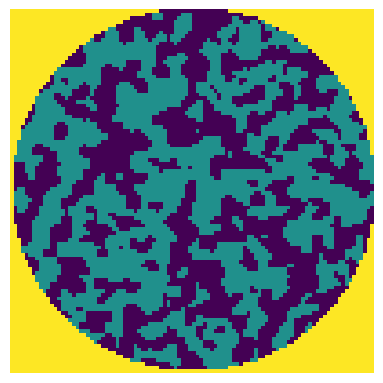porosity#
Porosity is the void volume divided by the bulk volume. In a boolean image this can be calculated with im.sum()/im.size, assuming the void voxels are labeled True. It can be slightly more complicated however, if the image does not fill up the full array (i.e. im.size is not the bulk volume) or if the there are other values in the image besides True (i.e. it’s not obvious what is void space). The porosity function works as np.sum(im == 1)/np.sum(im == 0). This means that any voxels marked something else are ignored. It’s still very simple, but is more robust which comes in handy.
import matplotlib.pyplot as plt
import numpy as np
import porespy as ps
ps.visualization.set_mpl_style()
im#
In its basic form a binary image is fine:
im = ps.generators.blobs(shape=[200, 200], seed=0)
e = ps.metrics.porosity(im)
print(e)
0.5
However, if the image is has some unfilled space, the around a cylindrical tomogram, then it can be labelled as 2 so it’s ignored:
im = ps.generators.blobs(shape=[100, 100, 100], porosity=0.5, blobiness=2).astype(int)
cyl = ps.generators.cylindrical_plug(shape=im.shape, axis=0)
im[~cyl] = 2
fig, ax = plt.subplots(figsize=[4, 5])
ax.imshow(im[50, ...], interpolation="none", origin="lower")
ax.axis(False)
e = ps.metrics.porosity(im)
print(e)
0.4968664536741214

The porosity specified when generating the blobs image was 50%, and the computed porosity is also 50%, despite having a regions of 2’s around the outside.
